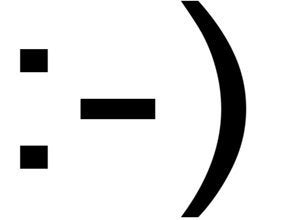
There is a very special place in hell reserved for whoever created the emoticon. Nor can we blame the scourge solely on text messaging and e-mail: as far back as the 19th century, writers ended their sentences with a colon and parentheses perverted into a frowny or smiley face. No less an eminent figure than Abraham Lincoln may have deployed a ;) in an 1862 speech, something that scholars have stridently insisted was a typo and not a sign that one of our nation's most revered presidents surrendered to the temptation to punctuate like a 14-year-old girl.
Then again, Lincoln won the Civil War, so he can perhaps be forgiven if that emoticon was an intentional one. But if you didn't save a nation from tearing itself apart, and if you're not a teenager with a phone and a pair of hyperactive thumbs, then eliminating emoticons from your writing lexicon is probably in everyone's best interest.
The maxim also applies to abbreviations such as LOL, LMAO, OMG, BRB and their ilk. Centuries from now, future historians will pour over any e-mail printouts we've left behind, and marvel at the strange codes we used to communicate with each other. They'll wonder: What do these arcane letters mean? What incredible subtext and nuance do they convey? Little will they know that LOL was meant only to convey the knee-slapping, gut-busting hilarity of yet another photo of a kitten dressed in a top hat. Even if it means spending a few additional minutes composing a phrase or paragraph, an intellectual prefers to deploy actual words in the name of nuanced arguments and insights, instead of relying on the blunt instrument of OMG LMAO BFN.
Putting This Theory Into Practice
Emoticons likely originated out of distrust and fear in the power of the written word. The hesitant writer, unsure if "I had a great weekend" truly conveys that they had a great weekend, is inclined to tap out a :-) after the period.
Have faith in words to convey your point. If you feel a sentence is somehow ambiguous, rewrite it for greater clarity. After that, if your hesitation persists, feel free to add another sentence (or two) to buttress the first one: "I had a great weekend. Really. I'm serious." That could add a whole three seconds to the time it takes to type your message, a collective sacrifice we'll have to make as a nation in order to eliminate the horror of emoticons once and for all.
And the Inevitable Footnote...
In 1969, an interviewer reportedly asked Vladimir Nabokov to place himself among the ranks of writers, living and dead. "I often think there should exist a special typographical sign for a smile," he replied. "Some sort of concave mark, a supine round bracket, which I would now like to trace in reply to your question."
One could argue that, if Nabokov condoned the use of an emoticon as a way to sidestep graceless questions, then such typography should be available for anyone's use. That being said, it's also highly probable that the author of Lolita was being a little bit sardonic in that instance. ;-)
Adapted from How to Become an Intellectual, a firmly tongue-in-cheek guide to becoming a truly brainy thinker, published by Adams Media in April 2012.